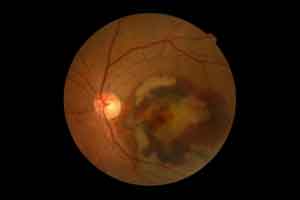- Home
- Editorial
- News
- Practice Guidelines
- Anesthesiology Guidelines
- Cancer Guidelines
- Cardiac Sciences Guidelines
- Critical Care Guidelines
- Dentistry Guidelines
- Dermatology Guidelines
- Diabetes and Endo Guidelines
- Diagnostics Guidelines
- ENT Guidelines
- Featured Practice Guidelines
- Gastroenterology Guidelines
- Geriatrics Guidelines
- Medicine Guidelines
- Nephrology Guidelines
- Neurosciences Guidelines
- Obs and Gynae Guidelines
- Ophthalmology Guidelines
- Orthopaedics Guidelines
- Paediatrics Guidelines
- Psychiatry Guidelines
- Pulmonology Guidelines
- Radiology Guidelines
- Surgery Guidelines
- Urology Guidelines
Viagra linked to irreversible damage to Color Vision

Color vision problems caused by retinal damage on a cellular level may result from a high dose of sildenafil citrate, reports a new finding published in the journal Retinal Cases. Sildenafil citrate is an ingredient used in some erectile dysfunction medication.
The study results of Mount Sinai researchers have shown that excessive use of the drug could lead to long-term vision problems, including possible irreversible damage.
“People live by the philosophy that if a little bit is good, a lot is better. This study shows how dangerous a large dose of a commonly used medication can be,” said lead investigator Richard Rosen.“People who depend on colored vision for their livelihood need to realize there could be a long-lasting impact of overindulging on this drug.”
The findings of the study were based on a 31-year-old patient who arrived at an urgent care clinic complaining of red-tinted vision in both eyes that hadn’t gone away in two days. He reported that his symptoms began shortly after taking a dose of liquid sildenafil citrate that he purchased over the internet (sildenafil citrate can cause visual disturbances with normal dosage, but symptoms typically resolve within 24 hours). The patient told doctors he had consumed much more than the recommended 50mg dose, and those symptoms began shortly after ingestion. The patient was then diagnosed with persistent retinal toxicity linked to the high dose of medication damaging the outer retina. His tinted vision has not improved more than a year after his initial diagnosis, despite various treatments.
Read Also: Gene therapy shows promise for reversing blindness
“To actually see these types of structural changes was unexpected, but it explained the symptoms that the patient suffered from. While we know colored vision disturbance is a well-described side effect of this medication, we have never been able to visualize the structural effect of the drug on the retina until now,” said Dr. Rosen. “Our findings should help doctors become aware of potential cellular changes in patients who might use the drug excessively, so they can better educate patients about the risks of using too much.”
The patient was diagnosed with adaptive optics (AO) and optical coherence tomography (OCT), to examine the retina for evidence of structural damage at the cellular level.
With the help of this high-tech imaging, investigators were able to see the microscopic injury to the cones of the retina, the cells which are responsible for color vision. The damage was similar to that seen in animal models of hereditary retinal disease such as retinitis pigmentosa or cone-rod dystrophy.
AO is a sophisticated technology that allows clinicians to examine microscopic structures of the eye in living patients with extreme detail in real time. OCT is an advanced imaging system that reveals the cross-sectional details of the retina layer by layer.
For reference log on to http://10.1097/ICB.0000000000000708

Disclaimer: This site is primarily intended for healthcare professionals. Any content/information on this website does not replace the advice of medical and/or health professionals and should not be construed as medical/diagnostic advice/endorsement or prescription. Use of this site is subject to our terms of use, privacy policy, advertisement policy. © 2020 Minerva Medical Treatment Pvt Ltd